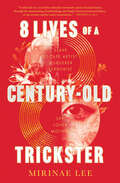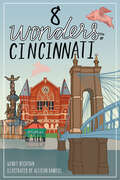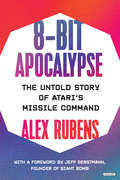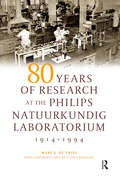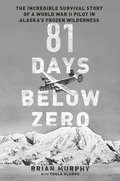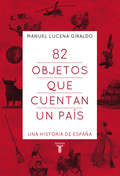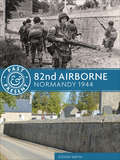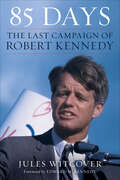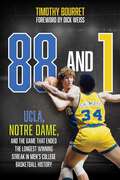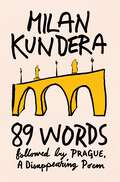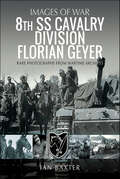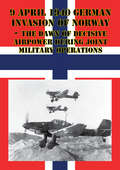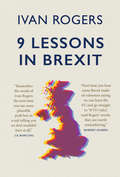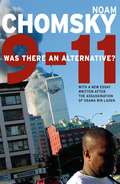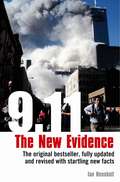- Table View
- List View
747: Creating the World's First Jumbo Jet and Other Adventures from a Life in Aviation
by Jay Spenser Joe SutterThis is the thrilling story behind "the Queen of the Skies"--the Boeing 747--as told by Joe Sutter, one of the most celebrated engineers of the twentieth century, who spearheaded its design and construction. Born in 1921 in Seattle, Sutter grew up on a hilltop overlooking the Boeing plant and flying field. It was a thrilling era of open cockpits, silk scarves, leather helmets, and goggles. After serving in World War 2, Sutter joined Boeing, then a small company, eager to build airplanes. In July 1965, he was asked to lead the large Boeing team designing the new 747. Pan Am wanted a new airliner as quickly as possible. This all-new transport had to be far bigger than anything in service or even on anybody's drawing board. To make it fly, Sutter and his team would have to push far beyond the technological boundaries of the late 1960s. Could it be done? Almost everything about the 747 would be unprecedented. Its cabin would be so wide that it would need two aisles. Its horizontal tail would be bigger than the wings of most airliners ever built. Jet engines big enough to lift it off the ground didn't yet exist. Runways at the world's airports couldn't handle it, and neither could Boeing's factories. They had to erect the world's largest building just to produce it. A truly mammoth undertaking, the 747 became one of the most successful airplane models ever. Sutter's vivid narrative takes us back to a time when American technology was cutting-edge--the 747, came on the market the same year that men first set foot on the moon--and jet travel was still glamorous and new. With wit and warmth, he gives an insider's sense of the larger-than-life-size personalities and the tensions in the aeronautical world. Ultimately, 747 is an inspiring story of grit and glory.
75 Masterpieces Every Christian Should Know: The Fascinating Stories Behind Great Works of Art, Literature, Music and Film
by Terry GlaspeyLet Your Faith Be Moved by the MasterpiecesArt becomes a masterpiece when it stands the test of time and challenges its viewers to see the world from a new perspective. The vast legacy of human expression is therefore a rich resource of introspection and wisdom for Christians today. 75 Masterpieces Every Christian Should Know anthologizes some of humanity&’s most influential and renowned works of art. Terry Glaspey masterfully analyzes how each piece responds to the reality of the human condition and Christian truth. Glaspey examines architecture, plays, novels, paintings, films, and even albums, evoking how some probe the dark corners of human suffering, while others capture the mystery, beauty, and wonder of life. Each selection is universally revered for its craftsmanship and ubiquitously esteemed across both time and cultures. From Rembrandt&’s The Return of the ProdigalSon to Jane Austen&’s Pride and Prejudice to Johnny Cash&’s At Folsom Prison, every masterpiece reveals some truth that has both enriched the Christian faith and left an indelible mark on the legacy of artistic achievement. Through engaging these masterpieces, Christians today can enrich their own faith with the creativity of history&’s brilliant artists.This book serves as both historian and biographer, as devotional and art criticism. May this book be a modest doorway into a world of deeper appreciation, a guide to the treasures of our tradition that enriches both your faith and understanding of the human experience.
75 Masterpieces Every Christian Should Know: The Fascinating Stories Behind Great Works of Art, Literature, Music and Film
by Terry GlaspeyLet Your Faith Be Moved by the MasterpiecesArt becomes a masterpiece when it stands the test of time and challenges its viewers to see the world from a new perspective. The vast legacy of human expression is therefore a rich resource of introspection and wisdom for Christians today. 75 Masterpieces Every Christian Should Know anthologizes some of humanity&’s most influential and renowned works of art. Terry Glaspey masterfully analyzes how each piece responds to the reality of the human condition and Christian truth. Glaspey examines architecture, plays, novels, paintings, films, and even albums, evoking how some probe the dark corners of human suffering, while others capture the mystery, beauty, and wonder of life. Each selection is universally revered for its craftsmanship and ubiquitously esteemed across both time and cultures. From Rembrandt&’s The Return of the ProdigalSon to Jane Austen&’s Pride and Prejudice to Johnny Cash&’s At Folsom Prison, every masterpiece reveals some truth that has both enriched the Christian faith and left an indelible mark on the legacy of artistic achievement. Through engaging these masterpieces, Christians today can enrich their own faith with the creativity of history&’s brilliant artists.This book serves as both historian and biographer, as devotional and art criticism. May this book be a modest doorway into a world of deeper appreciation, a guide to the treasures of our tradition that enriches both your faith and understanding of the human experience.
778 Orreaga. El nacimiento de un reino
by Arantzazu Ametzaga IribarrenHay momentos en los que los pueblos cambian el rumbo de su historia. Sucede en contadas ocasiones y exige la convergencia de muchas voluntades dispares. En esta novela Arantzazu Ametzaga nos narra con pasión uno de esos episodios, quizás el más relevante y desconocido, aquel que tuvo por epicentro un desfi ladero pirenaico allá por el mes de agosto del año 778. Y lo hace de forma documentada y amena, entretejiendo historias vitales articuladas en dos líneas temporales: el siglo VIII, acompañando a la expedición de Carlomagno a Vasconia, y el siglo XIII, en torno a la elaboración de las vidrieras de la catedral de Chartres. Un relato cautivador para evocar la gesta que, a la postre, dio lugar al nacimiento del primer reino vascón.
7th SS Mountain Division Prinz Eugen At War, 1941–1945: A History of the Division (Images of War)
by Ian BaxterThis volume of rare WWII photographs presents a pictorial history of the Nazi mountain infantry division that fought in Croatia and the Balkans. Drawing on a superb collection of rare and unpublished photographs, this book tells the story of the 7th SS Mountain Division during the Second World War. Formed in 1941, it consisted of both volunteers and conscripts from the Banat, Independent State of Croatia, Hungary and Romania. The Prinz Eugen SS Division fought a brutal counterinsurgency campaign against the communist-led Yugoslav Partisan resistance forces in occupied Serbia and Montenegro. It was given the title Prinz Eugen after Prince Eugene of Savoy, a 17th century military leader of the Habsburg Empire. Covering the Divisions history from formation to the end of the war, this volume includes chapters on Operation Weiss, guerilla warfare, and other topics.
8 Lives of a Century-Old Trickster: A Novel
by Mirinae LeeJoining the acclaimed ranks of Pachinko and A Woman is No Man, a riveting and genre-bending debut of love and survival, set in the demilitarized zone separating North and South Korea.Life near the North Korean border is a zero-sum game, an ongoing battle in which you either win or you lose. This dangerous, shadowed netherworld is home to an unforgettable woman known only as the “trickster.”Inspired by the story of Lee’s great aunt, one of the oldest women to escape alone from North Korea, 8 Lives of a Century Old Trickster consists of eight dark and spellbinding chapters that follow this remarkable character and her family as they struggle to survive during the most turbulent times of modern Korean history. Mirinae Lee’s trickster is a shapeshifter—throughout the course of these interconnected chapters she is a slave, an escape artist, a murderer, a terrorist, a spy, a lover, and a mother—a woman who must often choose the unthinkable to survive war and conquest in Korea. Her story is a beguiling, complex tale of love and survival that will keep you riveted—and speculating—until the very end thanks to Lee’s brilliant talent for sleight of hand.A fascinating look at survival, trauma, and family, 8 Lives of a Century-Old Trickster is an incredible literary debut from a bright new talent.
8 Seconds of Courage: A Soldier's Story from Immigrant to the Medal of Honor
by Tom Sileo Flo GrobergIn an inspiring story of valor and the making of a hero, Florent Groberg—who grew up in France and emigrated to the US—becomes the first immigrant in forty years to receive the Congressional Medal of Honor after he tackled a suicide bomber in Afghanistan.Florent &“Flo&” Groberg was born in the suburbs of Paris and moved to the US with his family in middle school. He became a naturalized citizen in 2001. After attending the University of Maryland, he joined the US Army and twice deployed to Afghanistan. In August of 2012, Flo was guarding a high-level US-Afghan delegation and noticed someone suspicious: a local man stumbling toward his patrol. Flo reacted quickly and ran to tackle the man—who was wearing a suicide vest. Four people died in the subsequent explosion, but many others were spared. Flo himself spent the next three years undergoing surgeries at Walter Reed Medical Center, and in 2015 he was given the nation&’s highest military award, the Congressional Medal of Honor—the first immigrant to be so recognized since the Vietnam War. What prepares a soldier for those critical moments in combat? 8 Seconds of Courage tells Flo&’s story from his childhood in France to his decision to enlist and the grueling training he underwent at US Army Ranger School. As a field commander on the front lines in Afghanistan he formed close and lasting bonds with his fellow soldiers. It was this powerful sense of responsibility that compelled him to take action to save lives, even at the risk of his own. &“Flo&’s incredible tale of bravery and service is also a stark reminder that for many of our warriors, coming home is not the end of the fight. Flo finds a way to live…Truly an inspiration&” (Jon Stewart). In his own words, Flo provides that essential insight into his selfless act while remembering his four fallen brothers in arms. 8 Seconds of Courage is a story of heroism, sacrifice, and camaraderie in wartime.
8 Wonders of Cincinatti
by Wendy BeckmanCincinnati is an amazing place to live and visit for so many reasons. Local author Wendy Beckman and illustrator Allison Ranieri celebrate the city's eight wonders--architecture, art, commerce, food, customs, geography, history and people. With its Venetian Gothic lancet arches and crystal chandeliers, the Cincinnati Music Hall stands as an architectural masterpiece. The Cincinnati Red Stockings made history as the first professional baseball team. Remnants of marine fossils from the Ordovician Period remind residents that the city was once under water. Limitless local varieties of goetta range from family recipes to trendy café dishes. And the city birthed trailblazers like track and field star DeHart Hubbard, the first African American to win an Olympic gold medal in an individual event. These stories and more reveal the unique character of the Queen City.
8-Bit Apocalypse: The True Story Behind The Classic Video Game
by Alex Rubens Jeff GerstmannThe first history of Atari’s Missile Command, and its unforeseen effects on its creators and the culture Before Call of Duty, before World of Warcraft, before even Super Mario Bros., the video game industry exploded in the late 1970s with the advent of the video arcade. Leading the charge was Atari Inc., the creator of, among others, the iconic game Missile Command. The first game to double as a commentary on culture, Missile Command put the players’ fingers on “the button,” making them responsible for the fate of civilization in a no-win scenario, all for the price of a quarter. The game was a marvel of modern culture, helping usher in both the age of the video game and the video game lifestyle. Its groundbreaking implications inspired a fanatical culture that persists to this day. As fascinating as the cultural reaction to Missile Command were the programmers behind it. Before the era of massive development teams and worship of figures like Steve Jobs, Atari was manufacturing arcade machines designed, written, and coded by individual designers. As earnings from their games entered the millions, these creators were celebrated as geniuses in their time; once dismissed as nerds and fanatics, they were now being interviewed for major publications, and partied like Wall Street traders. However, the toll on these programmers was high: developers worked 120-hour weeks, often opting to stay in the office for days on end while under a deadline. Missile Command creator David Theurer threw himself particularly fervently into his work, prompting not only declining health and a suffering relationship with his family, but frequent nightmares about nuclear annihilation. To truly tell the story from the inside, tech insider and writer Alex Rubens has interviewed numerous major figures from this time: Nolan Bushnell, founder of Atari; David Theurer, the creator of Missile Command; and Phil Klemmer, writer for the NBC series Chuck, who wrote an entire episode for the show about Missile Command and its mythical “kill screen.” Taking readers back to the days of TaB cola, dot matrix printers, and digging through the couch for just one more quarter, Alex Rubens combines his knowledge of the tech industry and experience as a gaming journalist to conjure the wild silicon frontier of the 8-bit ’80s. 8-Bit Apocalypse: The Untold Story of Atari's Missile Command offers the first in-depth, personal history of an era for which fans have a lot of nostalgia.
80 Years of Research at the Philips Natuurkundig Laboratorium (1914-1994): The Role of the Nat. Lab. at Philips
by Jan Korsten Marc VriesHistories of major industrial research laboratories are an essential contribution to the history of technology. This book offers a description of the way one of such laboratories has changed its ambitions and activities in the course of time. In the 80-year period that is described here, the Philips Natuurkundig Laboratorium has played different roles for the Philips company – today one of the world’s largest electronics company – which was founded in 1891 in the Netherlands. The history of this laboratory is described in three main periods, each characterized by its goals, available means, organizational structures, research culture, and external relations. For each period the general story line is alternated by case study descriptions.The Philips Natuurkundig Laboratorium was founded in 1914. The term ‘Natuurkundig’ (in English: of physics) indicated that the task of the new laboratory was to conduct research of physics. Initially this research was related to light bulbs. At that time the Philips company, led by the two Philips brothers Anton and Gerard, was primarily a light bulb producing company. Soon the Nat.Lab. (this is the commonly used abbreviation of the full name) became the main source of inventions that would support the company in extending its product portfolio. In the course of time the goal of the lab’s activities shifted in response to changes in its context, both within the Philips company and in a broader national and international context. Today the Philips Natuurkundig laboratorium is part of a worldwide research organization, Philips Research that generates options for new and improved products and processes and produces important patents in those electronics markets in which the company is active. It is still one of the world’s major private research organizations. A key characteristic is the wide range of disciplines that are represented: from electrical engineering and physics to chemistry, mathematics, mechanics, information technology and software.
800 Years of Haunted Liverpool
by John ReppionThis creepy collection of true life tales takes the reader on a tour through the streets, cemeteries, alehouses, attics and docks of Liverpool. Drawing on historical and contemporary sources and containing many tales which have never before been published, it unearths a chilling range of supernatural phenomena, from the Grey Lady of Speke Hall to the ghost of John Lennon airport. Copiously illustrated with photographs, maps and drawings, this book will delight anyone with an interest in the supernatural history of the area. It is the first complete guide to the paranormal history of the region.
81 Days Below Zero: The Incredible Survival Story of a World War II Pilot in Alaska's Frozen Wilderness
by Brian MurphyShortly before Christmas in 1943, five Army aviators left Alaska’s Ladd Field on a test flight. Only one ever returned: Leon Crane, a city kid from Philadelphia with little more than a parachute on his back when he bailed from his B-24 Liberator before it crashed into the Arctic. Alone in subzero temperatures, Crane managed to stay alive in the dead of the Yukon winter for nearly twelve weeks and, amazingly, walked out of the ordeal intact. 81 Days Below Zero recounts, for the first time, the full story of Crane’s remarkable saga. In a drama of staggering resolve with moments of phenomenal luck, Crane learned to survive in the Yukon’s unforgiving landscape. His is a tale of the human capacity to endure extreme conditions and intense lonelinessand emerge stronger than before.
82 Days on Okinawa: One American's Unforgettable Firsthand Account of the Pacific War's Greatest Battle
by Robert L. Wise"A gritty, first-person account. ... One can hear Shaw’s voice as if he were sitting beside you." —Wall Street JournalAn unforgettable soldier’s-eye view of the Pacific War’s bloodiest battle, by the first American officer ashore Okinawa. On Easter Sunday, April 1, 1945, 1.5 million men gathered aboard 1,500 Allied ships off the coast of the Japanese island of Okinawa. The men were there to launch the largest amphibious assault on the Pacific Theater. War planners expected an 80 percent casualty rate.The first American officer ashore was then-Major Art Shaw (1920-2020), a unit commander in the U.S. Army’s 361st Field Artillery Battalion of the 96th Infantry Division, nicknamed the Deadeyes. For the next three months, Shaw and his men served near the front lines of the Pacific’s costliest battle, their artillery proving decisive against a phantom enemy who had entrenched itself in the rugged, craggy island. Over eighty-two days, the Allies fought the Japanese army in a campaign that would claim more than 150,000 human lives. When the final calculations were made, the Deadeyes were estimated to have killed 37,763 of the enemy. The 361st Field Artillery Battalion had played a crucial role in the victory. The campaign would be the last major battle of World War II and a key pivot point leading to the bombings of Hiroshima and Nagasaki, and to the Japanese surrender in August, two months after the siege’s end.Filled with extraordinary details, Shaw’s gripping account gives lasting testimony to the courage and bravery displayed by so many on the hills of Okinawa.
82 objetos que cuentan un país: Una historia de España
by Manuel LucenaUn recorrido excepcional por la historia de España a través de sus objetos. Frente a lo que hacen otras historias de España, este libro propone un camino de estudio distinto, pues rastrea la existencia milenaria del país en su cultura material y emocional. Alejada de cualquier esencialismo, no narra lo que los objetos «son», sino lo que han representado para los españoles a través de los tiempos. Es esta una relación identitaria, pero, por encima de todo, pasional y utilitaria. Los españoles han proyectado en los 82 objetos que componen la obra múltiples contenidos simbólicos. En los textos dedicados a cada uno de ellos hay elementos descriptivos -qué es cada uno-, analíticos -de qué manera se configuró su contexto- y relacionales -de qué forma fueron considerados únicos en cada momento histórico, cómo adquirieron una pátina o configuración determinada-. Pero, sobre todo, portan significado por el aura que contienen, el amorcon que fueron fabricados y la evocación que provocan en nosotros. Prehistoria, España romana, Edad Media, los Austrias, Ilustración, siglo XIX, siglo XX y el tiempo presente son las partes en que está dividido 82 objetos que cuentan un país. Sigue, por tanto, una cronología clásica, aunque puesta al día. El número y selección de los objetos se ha basado en un intento de acumulación densa y en caracterizaciones canónicas procedentes de diversos ámbitos y disciplinas. No asumen distinciones arcaicas entre «alta cultura» y «cultura popular»; tampoco son siempre materialidades concretas, sino en ocasiones difusas y flexibles, pues el ingenio de los españoles se ha plasmado a lo largo de los siglos en los más variados campos del arte y la cultura, la moda, la política, la cartografía, la numismática, la ciencia o la ingeniería. Reseña:«La historia de España por una original vía paralela a los hechos, a través de los objetos que la jalonan.» Miguel Lorenci, Colpisa «Imágenes y textos de calidad que, a modo de rompecabezas bien encajado, nos reflejan como pueblo y promueven una introspección colectiva que sobrecoge, emociona y estimula a partes iguales.»Ignacio Andrade/Carlos Rubio, Interviú
82nd Airborne: Normandy 1944 (Past & Present Series)
by Stephen Smith Simon Forty<p>An account of the heroic D-Day actions of the US Army’s first airborne division in the series that brings World War II battles to life.<p> <p>Since its formation on August 15, 1942, the 82nd Airborne, commanded by Major General Matthew B. Ridgway, trained exhaustively for their new role, which involved parachuting from C-47s and insertion by Waco CG-4A gliders. After participating in the invasion of Sicily and performing night parachute drops onto the Salerno beachhead in September 1943, the bulk of the division left for the United Kingdom and training for D-Day.<p> <p>Reorganized with two new parachute infantry regiments, the 507th and the 508th, joining the 505th, the division dropped onto the Cotentin peninsula between Ste-Mère-Église and Carentan on the night of June 5–6, in a mission codenamed Boston. Their glider-borne component, the 325th GIR, arrived the next day. Widely dispersed on landing, the division overcame its problems and strong German defenses to take the important town of Ste-Mère-Église. Further intense action along the Merderet River ensured that the Utah beachhead wasn’t compromised, and subsequently, the division fought on losing 5,245 troopers killed, wounded, or missing. When withdrawn after 33 days of action, the division could be satisfied it had performed heroically and helped establish the Allied forces’ foothold in France.<p> <p>The Past & Present Series reconstructs historical battles by using photography, juxtaposing modern views with those of the past together with concise explanatory text. It shows how much infrastructure has remained and how much such as outfits, uniforms, and ephemera has changed, providing a coherent link between now and then.<p>
83 Days in Mariupol: A Graphic Novel
by Don BrownA young adult graphic novel that captures the complexities of the war in Ukraine, focusing on the siege of Mariupol (Feb ’22 – May ’22) and the brave people who stayed to defend their city against Russian forces as well as the resulting effects on global politics.A city ruined. In once quiet residential streets, two armies battle, driving people into cellars and basements with little food or water. No lights or heat. Dwindling medical supplies. Shells and bullets deliver cruel, random death to the young and old, men, women, and children. This is Mariupol, a Ukrainian city and early target of Russia’s invasion of Ukraine. Bordering Russian-occupied territory, the coastal city seemed doomed to a defeat that would come within days, if not hours. Could Mariupol, and Ukraine, survive? As Russian rockets threatened the city, Ukrainians resisted, and with a heroic combination of sacrifice and bravery, the besieged city endured . . . for months. But it all came at a steep cost.With compassion and his keen journalist’s eye, Sibert Honor creator Don Brown illuminates the horrors of Mariupol and the depredations of its people not seen in the city since World War II. He also shows that outside of Mariupol, the city’s agonies were mirrored by similar events occurring in towns and cities across Ukraine.83 Days in Mariupol reminds us that the bloody defiance shown at the Alamo, Dunkirk, Leningrad, and Thermopylae isn’t confined to the past but has a violent, modern presence. It is the story of senseless destruction, patriotism, and grit against long odds—a brutal battle whose consequences still reverberate across Ukraine and continue to reshape the global political landscape.Read more books by Don Brown:Run and Hide: How Jewish Youth Escaped the Holocaust In the Shadow of the Fallen Towers: The Seconds, Minutes, Hours, Days, Weeks, Months, and Years after the 9/11 AttacksFever Year: The Killer Flu of 1918The Unwanted: Stories of the Syrian Refugees
85 Days: The Last Campaign of Robert Kennedy
by Jules WitcoverThe “definitive account” (Washington Post) of Robert F. Kennedy’s seminal presidential campaign.85 Days is veteran Washington journalist Jules Witcover’s masterpiece of political reportage. It brilliantly captures a lost moment in time when the politics of conviction seemed to converge with America’s youth movement in opposition to the Vietnam War. At its center was the charismatic Robert F. Kennedy, brother of the slain President John F. Kennedy. Robert Kennedy’s impassioned opposition to the Vietnam War, and his vision for a more egalitarian United States, launched him on one of the most memorable, though brief, campaigns in U.S. political history.Witcover’s driving narrative follows Kennedy’s campaign throughout the primary season, as Kennedy mulled a run, developed his core issues and supporter base, and shot to the top of the polls, culminating in a victory in California just two days before he was tragically killed. A timeless work of political journalism, 85 Days captures the character and spirit of a man who came to symbolize an unforgettable era in America.
88 Days to Kandahar
by Robert L. GrenierThe First American-Afghan War, a CIA war, was approved by President George W. Bush and directed by the author, Robert Grenier, the CIA station chief in Islamabad. Forging separate alliances with warlords, Taliban dissidents, and Pakistani intelligence, Grenier launched the "southern campaign," orchestrating the final defeat of the Taliban and Hamid Karzai's rise to power in eighty-eight chaotic days.In his gripping narrative, we meet: General Tommy Franks, who bridled at CIA control of "his" war; General "Jafar Amin," a gruff Pakistani intelligence officer who saved Grenier from committing career suicide; Maleeha Lodhi, Pakistan's brilliant ambassador to the US, who tried to warn her government of the al-Qa'ida threat; "Mark," the CIA operator who guided Gul Agha Shirzai to bloody victory over the Taliban; General Ashfaq Pervaiz Kayani, a cautious man who became the most powerful man in Pakistan, struggling with Grenier's demands while trying to protect his country; and Hamid Karzai, the puzzling anti-Taliban insurgent, a man of courage, petulance, and vacillating moods. Grenier's enemies out in front prove only slightly more lethal than the ones behind his own lines. This first war is won despite Washington bureaucrats who divert resources, deny military support, and try to undermine the only Afghan allies capable of winning. Later, as he directed the CIA's role in the Iraq War, Grenier watched the initial victory squandered. His last command was of CIA's CounterTerrorism Center (CTC), as Bush-era terrorism policies were being repudiated, as the Taliban re-emerged in Afghanistan, and as Pakistan descended into fratricidal violence.
88 and 1: UCLA, Notre Dame, and the Game That Ended the Longest Winning Streak in Men's College Basketball History
by Timothy BourretUCLA&’s 88-game winning streak between 1970 and 1974 is undoubtedly one of the greatest accomplishments in the history of college sports. It is 28 games longer than any other streak in college basketball history and the closest anyone has come in the almost 50 years since it was established is UNLV&’s 45-game streak between 1989–91. John Wooden&’s team was so dominant that it won 48 of the 88 games by at least 20 points and had just eight wins by five or less. The Bruins&’ personnel featured multiple national player of the year selections, All-Americans, and 13 different players who went on to play in the NBA, including Bill Walton, Jamaal Wilkes, and Marques Johnson. 88 and 1 documents this incredible run and the losses that bracketed the streak, victories by Notre Dame over #1 ranked UCLA teams in the same building that was just a few miles from Wooden&’s home in the 1930s when he was a high school coach in South Bend. Author Timothy Bourret goes in depth on games and events leading up to that epic game on January 19, 1974, details on the game itself, culminating in Dwight Clay&’s game-winning shot in the final 30 seconds, and the aftermath. It also examines careers of the coaching combatants Digger Phelps and John Wooden, two unique personalities whose rivalry made this game must-see television.
89 Words followed by Prague, A Disappearing Poem
by Milan KunderaTwo newly translated works from one of the greatest literary writers and thinkers of the modern age, available together in English for the first time.Translating a work from its original language can be complicated; it’s a complex art that can easily mar and twist the intent and meaning of a writer’s words. Precise translations were of particular importance to Milan Kundera, who did not live to see all his books published in his native Czech language. Words, for Kundera, were the object of constant scrutiny.This fascinating volume includes two Kundera works from the 1980s, originally written for the now defunct French magazine Le Debat, which have never been available in in English. In “89 Words,” Kundera wryly recounts the many pitfalls in reading his own poorly translated works. When a friend of Kundera’s asked him about the words he considered the most—the ones he fretted over and loved—Kundera created a personal dictionary—his “89 Words.” This discerning essay, steeped in his signature barbed cheekiness, showcases his casually gutting philosophical reflections on what it means to be a writer in translation—the exile of life and art in another language.In the second work, “Prague: A Disappearing Poem,” Kundera writes with a wistfulness and despair for his ever-more-distant home, offering an intimate look at the specificity of his native culture: the richness of a heritage born in a “small nation” but whose significance is universal. Here, like in A Kidnapped West, we find the double condemnation of “Soviet civilization,” which had suffocated and persecuted Czech culture, and of Western Europe, which refused to neither acknowledge Kundera’s culture or understand it.Prefaced by lauded French historian Pierre Nora and translated from the French by award-winning Matt Reeck, these two texts return us to Kundera’s much-missed living presence. Subtle, alive, and full of wit and irony, 89 Words followed by Prague, A Disappearing Poem is an homage to a literary legend and a reminder of just how prescient his words and insights are today.
8th SS Cavalry Division Florian Geyer (Images of War)
by Ian BaxterCovers the operations of a leading SS Calvary Regiment and describes fighting under desperate conditions on the Eastern Front.Formed in 1942 8th SS Cavalry Division Florian Geyer was soon deployed to the Eastern Front where Hitler’s ambition to conquer Russia was stalling badly. In common with other SS units the Division was responsible for razing towns and villages, poisoning wells and genocide often against unarmed civilians. This scorched earth policy was aimed at hindering the Red Army’s advance. After moving South, the Division took part in the retreat from the Dnieper River before operating in Hungary and Croatia. The end came when trapped in Budapest by Soviet and Romanian forces, the Division was destroyed in December 1944. By the end of the siege only 800 of the 30,000 men in the SS Corps reached German lines. Using many startling contemporary images, this latest book in the Author’s Images of War series vividly illustrates the horror of warfare on the Eastern Front.
9 April 1940 German Invasion Of Norway - The Dawn Of Decisive Airpower During Joint Military Operations
by Major Brian T. BaxleyOperation Weserübung, the German invasion of Norway during the Second World War, is considered by many military historians to be the first joint military operation involving the combined planning and execution of air, land, and sea forces. After a brief introduction and an explanation of the significance of Norway, Chapter Three will analyze the planning process and strategy used by the Germans in late 1939 and early 1940 for devising this joint operation. Chapter Four examines, primarily from an airpower perspective, the plan itself and its execution during the first day of the operation by the Germans, and the British response. Chapter Five determines how German airpower was used, and in particular, what effect the Luftwaffe attack on 9 April against the British Home Fleet had against Britain's campaign strategy to control the North Sea. The final chapter examines three important lessons United States military planners should extract from Operation Weserübung and apply to operations in the 21st century. They are: 1) the joint operation of air, land, and sea assets produce a synergetic effect greater than the sum of their parts; 2) a difficult part of joint operations is the air command and control; and 3) airpower can decisively deny the enemy use of the land or the sea.
9 Lessons In Brexit
by Ivan RogersIn this short, elegant essay, Ivan Rogers, the UK"s former ambassador to the EU, draws up nine lessons for Brexit that we, as a soon-to-be `third country", need to learn from the last few years, if the next few years - indeed the next decade - are not to be even more painful.
9-11: Was There an Alternative?
by Noam ChomskyIn 9-11, published in November 2001 and arguably the single most influential post 9-11 book, internationally renowned thinker Noam Chomsky bridged the information gap around the World Trade Center attacks, cutting through the tangle of political opportunism, expedient patriotism, and general conformity that choked off American discourse in the months immediately following. Chomsky placed the attacks in context, marshaling his deep and nuanced knowledge of American foreign policy to trace the history of American political aggression--in the Middle East and throughout Latin America as well as in Indonesia, in Afghanistan, in India and Pakistan--at the same time warning against America's increasing reliance on military rhetoric and violence in its response to the attacks, and making the critical point that the mainstream media and public intellectuals were failing to make: any escalation of violence as a response to violence will inevitably lead to further, and bloodier, attacks on innocents in America and around the world. This new edition of 9-11, published on the tenth anniversary of the attacks and featuring a new preface by Chomsky, reminds us that today, just as much as ten years ago, information and clarity remain our most valuable tools in the struggle to prevent future violence against the innocent, both at home and abroad.
9.11: Fully Updated and Revised
by Ian HenshallThe original 9/11 Revealed attracted lavish praise from reviewers in the Daily Mail and Sunday Times for the 'huge gaps' it exposed in the official 9/11 story. It became a non-fiction bestseller despite a wall of silence by the broadcast media and condemnation in a special web page set up by the US State Department. Since then the story has produced many sinister new twists, including: Pentagon whistleblowers have accused the 'Independent 9/11 Commission' of lying; long-suppressed eyewitness testimony has been released confirming multiple explosions in the Twin Towers before and during their collapses; the much vaunted video purporting to prove that Flight 77 hit the Pentagon showed nothing at all; and an analysis of terrorist trials and arrests since 2001 indicates that far from the '600 Al Qaeda sleeper cells in the US' (CIA) there were none at all. In this sequel to 9/11 Revealed, Ian Henshall examines the precedents of black operations by the US/UK, from Northern Ireland to Italy, from Vietnam to Kosovo; he looks at the various 9/11 theories, including the latest twists in the official story, and tests them against the evidence. Finally, he asks what might happen when the storm of popular outrage collides with the regime in Washington and London and outlines the radical changes needed if Washington and London are ever again to function as genuine democracies.




